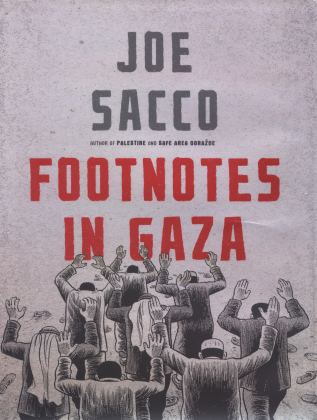Print Edition: March 28, 2012
 In his vividly-illustrated graphic novel Footnotes in Gaza, Joe Sacco gives readers a glimpse into the present day lives of disenfranchised Palestinians living in the Gaza Strip. At the same time he attempts, through the gathering of oral testimonies, to document several traumatic incidents in the history of Gaza.
In his vividly-illustrated graphic novel Footnotes in Gaza, Joe Sacco gives readers a glimpse into the present day lives of disenfranchised Palestinians living in the Gaza Strip. At the same time he attempts, through the gathering of oral testimonies, to document several traumatic incidents in the history of Gaza.
Footnotes in Gaza begins in 1948, with the creation of the independent state of Israel. After a brief history of the initial humanitarian crisis that followed the formation of Gaza, Sacco gathers firsthand accounts of what life was like during the first (1987) and second (2000) intifadas (Palestinian uprisings). Sacco, who is known for his war-reportage comics, moves fluidly from past to present day Gaza, and he discovers that for the poor of Gaza, living conditions have improved very little. Fundamentally, nothing has changed for the great grandchildren of the original Palestinian refugees.
Sacco’s focus throughout his novel is on two specific incidents that took place in 1956 in the Palestinian towns of Khan Younis and Rafah. The novel, for the most part, is narrated through eyewitnesses’ firsthand accounts, supplemented by Sacco’s research and made vivid by his own illustrations. On November 3, 1956, the Israeli army invaded Khan Younis, a small town in the Gaza Strip. Reports state 275 inhabitants of the town died as a result of that invasion. That same year, in the neighbouring town of Rafah, witnesses claim 111 Palestinian men were shot and killed by Israeli soldiers. These incidents were relegated to the dustbin of history before Sacco chose to investigate.
Sacco’s drawings are based on his own experience in Gaza as well as photographs from the United Nations Relief and Works Agency. His images, often close-up portraits, capture the despair of those he interviews. While the research Sacco did for this novel was largely done almost seven years ago, Sacco notes that the lives of Palestinians have not improved. With the election of Hamas, the Islamist political party that governs the area, Israel has declared the Gaza strip an “enemy entity,” making war a constant fear for civilians.
Khan Younis is where Sacco begins his investigation, a Palestinian town bordered by a Jewish settlement, tracing the events that led up to that one night in 1956. Palestinians crossing back into what were once their homes, now Israel, were seen as “infiltrators” and were killed on sight. In addition to Palestinian civilians, Sacco also interviews a former chef-de-bureau to the chief of staff in the Israeli army, who describes murders of Jews by these “infiltrators” and hence the justification for the retaliations by the Israeli army. One of these retaliations, according to Palestinian reports, left 42 unarmed Palestinian civilians dead, almost all of them women and children. The violence goes both ways, Sacco notes, but it is obvious in his story which side has the power. One of Sacco’s drawings of a young boy throwing a stone at a gun-toting Israeli soldier sums up the imbalance of power that the Palestinians faced, and still face today.
Many different firsthand accounts are pieced together to describe the two massacres in detail. The witnesses range from scarred survivors, old widows, sheikhs and former Israeli soldiers. The details vary, but the essential story remains the same. Sacco simply gives the reader a graphic (in both meanings of the word) narrative with as little bias as possible. The characters he portrays are darkly humourous, but also haunted by war, violence, poverty and oppression; they tell their stories with obvious pain, but do not ask for sympathy. A man shot 36 times in the back of the head chuckles at the soldier who failed to kill him.
Palestinians, Sacco says, do not seem to have “the luxury of digesting one tragedy” before the next is upon them. So why choose to focus on historical tragedies when such incidences are happening now? Sacco maintains that past and present “cannot be so easily disentangled.” To pause a moment and examine these events might, Sacco writes, be instructive to those who wish to understand why, as one interviewee says, hatred was “planted” in hearts.
Sacco’s unique form of comic-journalism depicts a bleak landscape burdened with the past. His research and attention to detail give a voice and a face to a people brought together through suffering. Footnotes in Gaza transforms a complex and deeply emotional conflict into an intimate experience.


